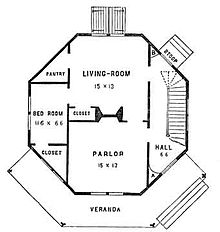Orson Fowler
Orson Squire Fowler (born October 11, 1809 in Cohocton , New York , † August 18, 1887 in Sharon , New York) was an American phrenologist who advocated the octagonal house in the mid-19th century .
Life
Horace and Martha (Howe) Fowler's son was born in Cohocton, Steuben County in 1809 . He attended Ashland Academy , studied at Amherst College, and graduated in 1834. Together with his brother Lorenzo Niles Fowler , he opened a phrenological office in New York City , wrote and taught from 1834 to 1889 on phrenology, health, general education and social reform.
From 1838 to 1842, Fowler published articles in the American Phrenological Journal , Philadelphia . From 1846 to 1854 he worked as a publisher ( Fowler & Wells ) in New York, lived in Fishkill , New York and Elizabeth , New Jersey . In 1863 he moved with his office to Boston , lived in Manchester , Massachusetts from 1863 to 1880 , and in Sharon from 1883 to August 18, 1887, where he died.
Fowler was married three times: to Eliza (Brevoort) Chevalier, to Mary (Aiken) Poole and to Abbie L. Ayres. He fathered three children. The town of Fowler , Colorado is named after him.
Octagonal houses
Fowler pointed out that an octagonal house would practically offer more space than the usual square or rectangle, and that the construction and heating costs would be lower. He went on to claim that octagonal houses are superior to rectangular houses in terms of room lighting, use of sunlight and air circulation, since there are no "dark, useless corners". Fowler thus triggered a veritable "octagonal movement" in parts of the USA, which is still evident today in numerous octagonal houses, mostly made of wood.
However, the octagon shape did not prevail over the long term, as disadvantages of this design were recognized. For example, the inner rooms in an octagonal floor plan often have unusual cuts, triangular for example, and thus very well "dark, useless corners". The advantage of better air circulation cited by Fowler also did not come true, since rooms with an octagonal floor plan often only have one front to the outside, in contrast to rooms with two fronts across the corner in a rectangular house.
In order to actually implement Fowler's ideas effectively, a design would possibly be necessary in which each individual room had an octagonal shape, but this was hardly ever realized.
Fowler saw himself as the "inventor" of the octagonal house, but there are also earlier examples, such as the summer house of Thomas Jefferson (1819).
Quotes
"Why so little progress in architecture when there is so much in other matters! Why continue to build in the same square form of all past ages?"
Works
- Memory and intellectual improvement (1841)
- Physiology, Animal and Mental (1842)
- Matrimony, or Phrenology applied to the Selection of Companions (1842)
- Self Culture and Perfection of Character (1843)
- Education and Self-improvement
- Hereditary Descent, its Laws and Facts applied to Human Improvement (1843)
- Love and Parentage (1844)
- The Self Instructor in Phrenology and Physiology (1849), with Lorenzo Fowler
- Sexual Science (1870)
- Phrenology proved, illustrated and applied
- Amativeness
- Human science
- Creative and Sexual Science, or Manhood, Womanhood, and their Interrelations (1875)
- The Octagon House: A Home for All
literature
- Debby Applegate : The Most Famous Man in America. The Biography of Henry Ward Beecher . Doubleday, New York NY 2006, ISBN 0-385-51396-8 .
- Madeleine Stern : Heads & Headlines. The Phrenological Fowlers. University of Oklahoma Press, Norman OK 1971.
See also
Web links
- Fowler's entry in Appleton's Cyclopedia of American Biography , 1889
- Orson Squire Fowler: Phrenology and Octagon Houses by John H. Martin
- About Fowler's Trip to Colorado ( February 19, 2005 memento in the Internet Archive )
- Directory of octagonal houses
| personal data | |
|---|---|
| SURNAME | Fowler, Orson |
| ALTERNATIVE NAMES | Fowler, Orson Squire |
| BRIEF DESCRIPTION | American phrenologist |
| DATE OF BIRTH | October 11, 1809 |
| PLACE OF BIRTH | Cohocton , New York |
| DATE OF DEATH | August 18, 1887 |
| Place of death | Sharon , New York |
